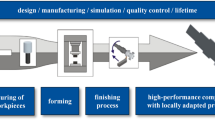Abstract
Finite element simulations for the press forming of a lower arm are performed using the explicit dynamic finite element method (FEM) code PAM-STAMP. To optimize the press-forming conditions and secure a safe product without any failure, such as fractures and wrinkling, the FEM simulations are coupled with Taguchi’s orthogonal array experiment. Three design variables—the friction coefficient, plastic anisotropy parameter, and blank shape—are selected to be optimized. The numeric simulations reveal that the blank shape is the most important variable, and its modification is most effective in optimizing the press-forming conditions for a lower arm. In addition, the modified blank shape produces a high yield ratio for the in-come coil. The simulation results are confirmed with experimental ones.
Similar content being viewed by others
References
Y.T. Keum, E. Nakamachi, R.H. Wagoner, and J.K. Lee:Int. J. Num. Meth. Eng., 1990, vol. 30, pp. 1471–502.
R.H. Wagoner and D. Zhou: inNumerical Methods in Industrial Forming Processes-NUMIFORM 92, edited by J.L. Chenot, R.D. Wood, and O.C. Zienkiewicz. Rotterdam, Netherlands, 1992, pp. 123–32.
PAM_STAMP version 2.1, User’s Manual, Pam System International, ESI-GROUP Software Product Company, Rungis, CEDEX, 1996.
M.S. Phadke and G. Taguchi:GLOBECOM’87 Meeting, IEEE Communications Society, Tokyo, Japan, 1987, pp. 1002–07.
M.S. Phadke:Quality Engineering Using Robust Design, Prentice-Hall International Inc., 1989.
ETA/FEMB Version 27, User’s Manual, Engineering Technology Associates, 1998.
Y.S. Kim and K.S. Kim:J. Kor. Soc. Tech. Plasticity, 1994, vol. 3 (1), pp. 51–62.
Y.S. Suh and R.H. Wagoner:J. Mater. Eng. Perform., 1996, vol. 5 (A), pp. 489–94.
Y.S. Kim, J.B. Nam, M.S. Chu, and Y.D. Kwon:Metal Trans. A, 2000, vol. 31 (A), pp. 83–98.
K.C. Park and Y.S. Kim:J. Mater. Proc. Tech., 1995, vol. 51, pp. 64–78.
A.K. Ghosh, S.S. Hecker, and S.P. Keeler: inSheet Metal Forming and Testing, Workablility Testing Techniques, edited by G.E. Dieter, ASM, Metals Park, Ohio, 1984, pp. 125–95.
Y.S. Kim:Theory of Engineering Plasicity, Sigma Press, Seoul, 2001.
Y.S. Kim and H.S. Son:J. Kor. Soc. Mech. Eng., 1999, vol. 23 (8), pp. 1380–87.
Author information
Authors and Affiliations
Rights and permissions
About this article
Cite this article
Kim, Y., Yang, S., Sohn, H. et al. Finite element analysis to optimize forming conditions for lower control arm. Metall Mater Trans A 37, 2539–2547 (2006). https://doi.org/10.1007/BF02586226
Received:
Issue Date:
DOI: https://doi.org/10.1007/BF02586226




